Study on the Organic Geochemical Characteristics of Jurassic Source Rocks from the Northern Tibetan Plateau Basin
Abstract
1. Introduction
2. Geological Setting
3. Samples and Methods
3.1. Samples
3.2. Methods
4. Results and Discussion
4.1. Organic Matter Abundance and Soluble Hydrocarbon Composition of Source Rocks
4.2. Types of Organic Matter in the Jurassic Source Rocks
4.3. Characteristics of Organic Matter Sedimentary Environment and Biomarker Compounds from Biological Sources
- (1)
- Organic matter sedimentary environment
- (2)
- Organic matter biological sources
4.4. Evaluation of Hydrocarbon Generation Potential of Jurassic Source Rocks
5. Conclusions
Author Contributions
Funding
Conflicts of Interest
References
- Kearney. Statistical Review of World Energy, 73rd ed.; Energy Institute: London, UK, 2024. [Google Scholar]
- Qin, J.Z. Depositional environment of the marine hydrocarbon source rock in the Qiangtang basin, Qinghai-Tibet plateau. Pet. Geol. Exp. 2006, 28, 8–14, (In Chinese with English Abstract). [Google Scholar]
- Wang, J.; Fu, X.G.; Shen, L.J.; Tan, F.W.; Song, C.Y.; Chen, W.B. Prospect of the potential of oil and gas resources in Qiangtang basin, Xizang (Tibet). Geol. Rev. 2020, 66, 1091–1113, (In Chinese with English Abstract). [Google Scholar]
- Wu, Z.H.; Ji, C.J.; Zhao, Z.; Chen, C. Buried depth evolution and hydrocarbon generation history of the Jurassic system in central Qiangtang Basin. Acta Geol. Sin. 2020, 94, 2823–2833, (In Chinese with English Abstract). [Google Scholar]
- Zhao, G.T.; Li, J.W.; Deng, X.; Cao, Z.Y. Geology characterization and hydrocarbon accumulation pattern of oil sand in Longeni of Qiangtang basin. Spec. Oil Gas Reserv. 2019, 26, 40–44, (In Chinese with English Abstract). [Google Scholar]
- Ding, W.L.; Li, C.; Su, A.G.; He, Z.H. Study on the comprehensive geochemical cross section of Mesozoic marine source rocks and prediction of favorable hydrocarbon generation area in Qingtang basin, Tibet. Acta Petrol. Sin. 2011, 27, 878–896. [Google Scholar]
- Gan, K.W. Evolution and hydrocarbon distribution of Thetysdomain. Mar. Orig. Pet. Geol. 2000, 5, 21–29. [Google Scholar]
- Jia, C.Z.; Yang, S.F.; Chen, H.L.; Wei, G.Q. Tectonic Geology and Natural Gas in Northern Tethys Basin Group; Petroleum Industry Press: Beijing, China, 2001. [Google Scholar]
- Fu, X.G.; Wang, J.; Tan, F.W.; Chen, M.; Li, Z.X.; Chen, W.B.; Feng, X.L. Recent progress in oil and gas geological exploration in the Qiangtang Basin, Northern Xizang. Sediment. Geol. Tethyan Geol. 2015, 35, 16–24, (In Chinese with English Abstract). [Google Scholar]
- Xu, L.; Luo, S.Q.; Tang, H.; Hu, L.; Xiao, J.; Sun, R.Y. Study on petroleum geological conditions in Dazhuom area of southern Qiangtang basin of Tibet. Geol. Surv. China 2020, 7, 16–24, (In Chinese with English Abstract). [Google Scholar]
- Wang, Z.J.; Wang, J.; Chen, W.X.; Fu, X.G. Discovery of the Late Jurassic Shenglihe marine oil shale in the northern Qiangtang basin, Qinghai-Tibet plateau. Geol. Bull. China 2007, 26, 764–768. [Google Scholar]
- Li, G.J.; Xia, G.Q.; Yi, H.S.; Ji, C.J.; Yang, J.B. Characteristics of the Mesozoic marine argillaceous source rocks and prediction of favorable hydrocarbon generation area in south Qiangtang Depression, Xizang (Tibet). Geol. Rev. 2020, 66, 1241–1259. [Google Scholar]
- Chen, W.B.; Liao, Z.L.; Zhang, Y.J.; Peng, Z.M. Geochemical characteristics and significance of hydrocarbon source rocks in the Jurassic Bi Qu formation in the north Qiangtang basin. Geol. China 2007, 34, 928–934. [Google Scholar]
- Tu, X.X.; Shen, B.; Shi, F.; Wang, S.Q.; Sun, W.L.; Xu, X.M. Determination of residual TOC in special samples-Taking Qiangtang basin as example. Sci. Technol. Eng. 2016, 16, 110–113. [Google Scholar]
- Decelles, P.; Kapp, P.; Ding, L.; Gehrels, G. Late cretaceous to middle tertiary basin evolution in the central Tibetan plat-eau: Changing environments in response to tectonic partitioning, aridification, and regional elevation gain. Geol. Soc. Am. Bull. 2007, 119, 654–680. [Google Scholar] [CrossRef]
- Ding, W.L.; Wan, H.; Zhang, Y.Q.; Han, G.Z. Charaeteristics of the Middle Jurassic marine source rocks and prediction of favor-able source rock kitchens in the Qiangtang basin of Tibet. J. Asian Earth Sci. 2013, 66, 63–72. [Google Scholar] [CrossRef]
- Wu, Z.H.; Gao, R.; Lu, Z.W.; Ye, P.S.; Lu, L.; Yin, C.Y. Structures of the Qiangtang basin and its significance to oil-gas exploration. Acta Geol. Sin. 2014, 88, 1130–1144, (In Chinese with English Abstract). [Google Scholar]
- Ma, A.L.; Hu, X.M.; Garzanti, E.; Han, Z.; Lai, W. Sedimentary and tectonic evolution of the southern Qiangtang basin: Impli-cations for the Lhasa-Qiangtang collision timing. J. Geophys. Res.-Solid Earth 2017, 122, 4790–4813. [Google Scholar] [CrossRef]
- Wang, Z.W.; Wang, J.; Fu, X.G.; Feng, X.L.; Armstrong-Altrin, J.S.; Zhan, W.Z.; Wan, Y.L.; Song, C.Y.; Ma, L.; Shen, L.J. Sedimentary auccessions and onset of the Mesozoic Qiangtang rift basin (northern Tibet), southwest China: Insights on the Palaeo and Meso-tethys evolution. Mar. Petrol. Geol 2019, 102, 657–679. [Google Scholar] [CrossRef]
- Huang, D.F.; Li, J.C.; Gu, X.Z. Evolution and Hydrocarbon Generating Mechanism of Terrigenous Organic Matter; Petroleum Industry Press: Beijing, China, 1984. [Google Scholar]
- Gao, G.; Xian, B.L.; Ren, J.L.; Zhang, W.W.; Ma, W.Y. Origin and source of natural gas from Wuxia fault belt in northern Mahu sag, Junggar basin. Nat. Gas Geosci. 2016, 27, 672–681. [Google Scholar]
- Chen, J.P.; Liang, D.G.; Zhang, S.C.; Deng, C.P.; Zhao, Z.; Zhang, D.J. Evaluation criterion and methods of the hydrocarbon generation potential for China’s paleozoic marine source rocks. Acta Geol. Sin. 2012, 86, 1132–1142, (In Chinese with English Abstract). [Google Scholar]
- Tissot, B.P.; Welte, D.H. Petroleum Fomation and Occurrence; Springer: Berlin/Heidelberg, Germany, 1994. [Google Scholar]
- Chen, W.B.; Liao, Z.L.; Liu, J.Q.; Fu, X.G.; Du, B.W.; Feng, X.L.; Du, Q.D. Geochemistry of the Jurassic source rocks in the south Qiangtang basin, Tibet. Geoscience 2010, 24, 654–661, (In Chinese with English Abstract). [Google Scholar]
- Fu, X.G.; Wang, J.; Wang, Z.J.; He, J.L. Characteristics of kerogens and their carbon isotope implications for the Shengli river oil shale in Qiangtang basin, northern Tibet. Acta Geosci. Sin. 2009, 30, 643–650, (In Chinese with English Abstract). [Google Scholar]
- Cornford, C. Organic Petrography of Lower Cretaceous Shales at DSDP Leg4 Site 398, Vigo Seamount, Eastern North Atlantic; Texas A & M University, Ocean Drilling Program: College Station, TX, USA, 1979; Volume 47, pp. 523–527. [Google Scholar]
- Xu, L.; Shi, Y.J.; Chen, X.D.; Wan, C.Z.; Wang, J.G. Kinetic analysis of hydrocarbon generation based on saline lacustrine source rock and kerogen in the western Qaidam Basin, China. Carbonates Evaporites 2018, 34, 1045–1053. [Google Scholar] [CrossRef]
- Hugher, W.B.; Holba, A.G.; Dzou, L.I.P. The ratios of dibenzothiophene to phenanthrene and pristane to phytane as indicators of depositional environment and lithology of petroleum source rocks. Geochim. Cosmochim. Acta 1995, 43, 739–745. [Google Scholar]
- Koopmans, M.P.; Rijpstra, W.I.; Klapwijk, M.M.; Leeuw, J.W.; Lewan, M.D.; Sinninghe Damste, J.S. A thermal and chemical degradation approach to decipher pristane and phytane precursors in sedimentary organic matter. Org. Geochem. 1999, 30, 1089–1104. [Google Scholar] [CrossRef]
- Ten Haven, H.L.; De Leeum, J.W.; Rullkotter, J. Restricted utility of the pristine/phytane ratio as a paleoenvironmental indicator. Nature 1987, 330, 641–643. [Google Scholar] [CrossRef]
- Moldowan, J.M.; Sundararaman, P.; Schoell, M. Sensitivity of biomarker properties to depositional environment and/or source input in the lower tocrcian of SW-Germany. Org. Geochem. 1986, 10, 915–926. [Google Scholar] [CrossRef]
- Peters, K.E.; Moldowan, J.M. The Biomarker Guide: Interpreting Molecular Fossils in Petroleum and Ancient Sediment; Prentice-Hall: Englewood Cliffs, NJ, USA, 1993. [Google Scholar]
- Pan, C.C.; Peng, D.H.; Zhang, M.; Yu, L.P.; Sheng, G.Y.; Fu, J.M. Distribution and isomerization of C31-C35 homohopanes and C29 steranes in oligocene saline lacustrine sediments from Qaidam Basin, Northwest China. Org. Geochem. 2008, 39, 646–657. [Google Scholar] [CrossRef]
- Fu, J.M.; Sheng, G.Y. Source and biomarker composition characteristics of Chinese non-marine crude oils. Acta Sedimentol. Sin. 1991, 9, 1–8. [Google Scholar]
- Duan, Y.; Wang, C.Y.; Zheng, C.Y. Geochemical study of crude oils from the Xifeng oilfield of the Ordos Basin, China. J. Asian Earth Sci. 2008, 31, 341–356. [Google Scholar] [CrossRef]
- Cheng, K.M. Oil and Gas Generation of Tuha Basin; Petroleum Industry Press: Beijing, China, 1994. [Google Scholar]
- Wu, Y.J.; Wang, S.; He, L.; Wang, Z.D.; Nie, Z.Q. Research on the burial history and the thermal evolution history of the Jurassic coal-measure source rocks in the eastern margin of Xiaocaohu Sag. Northwestern Geology. 2021, 54, 180–191, (In Chinese with English Abstract). [Google Scholar]
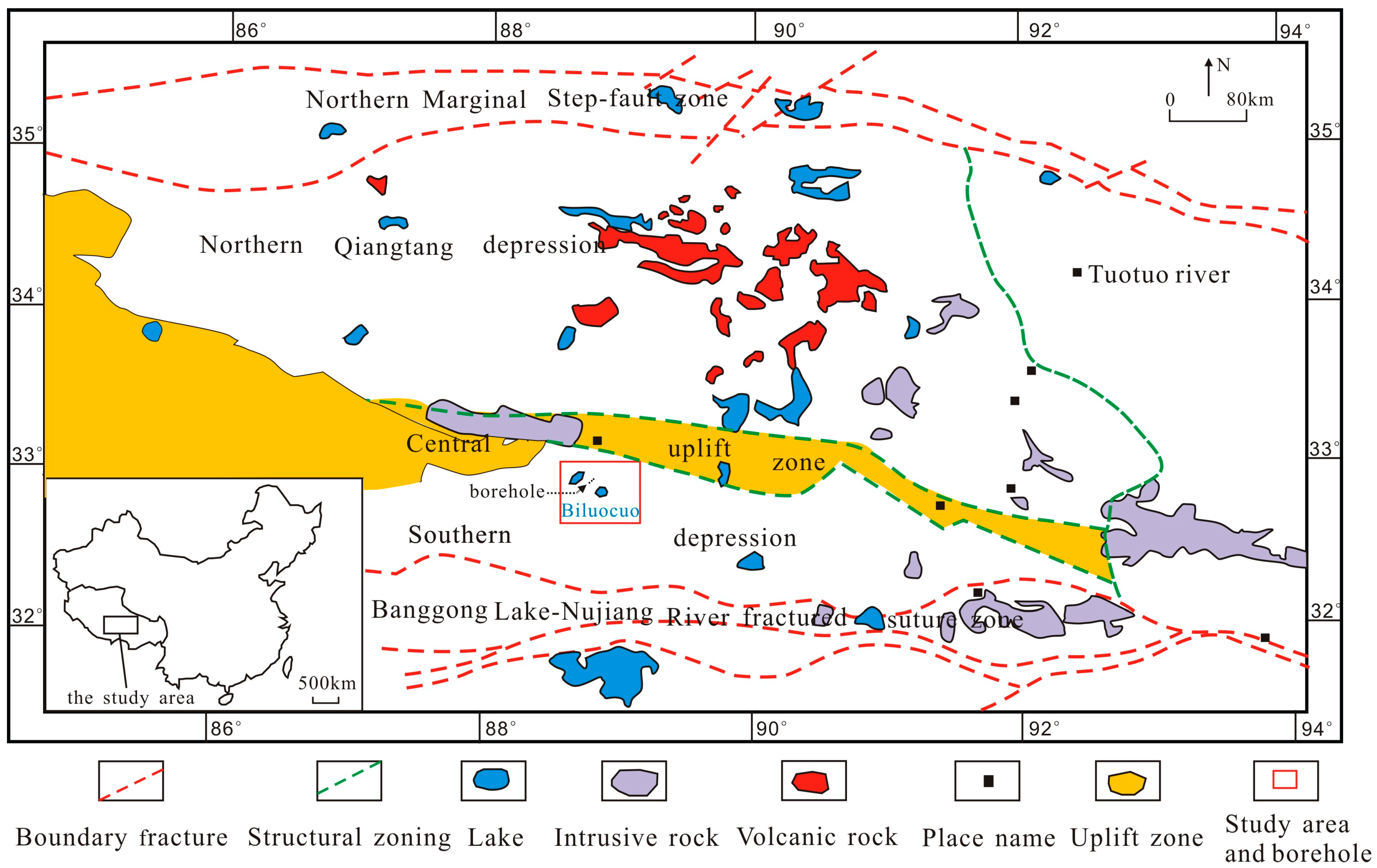



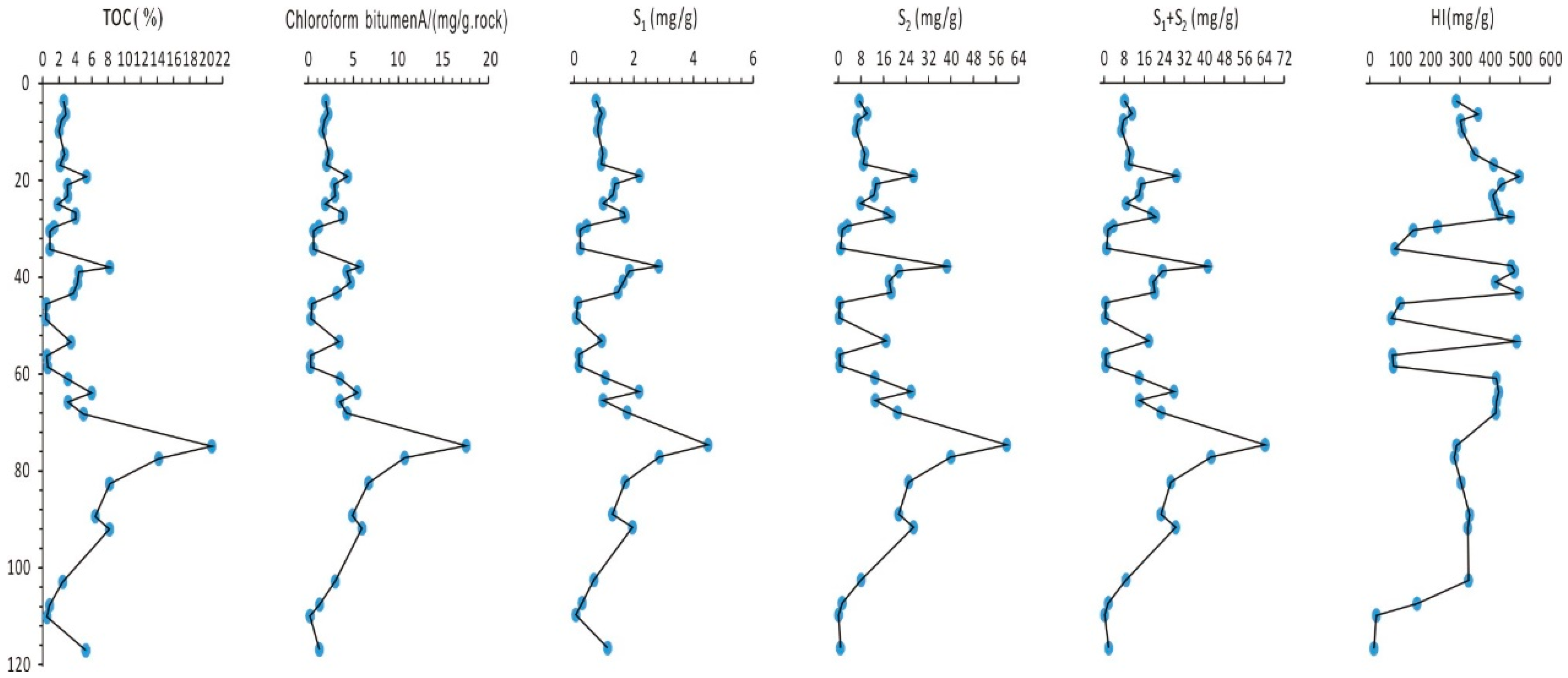
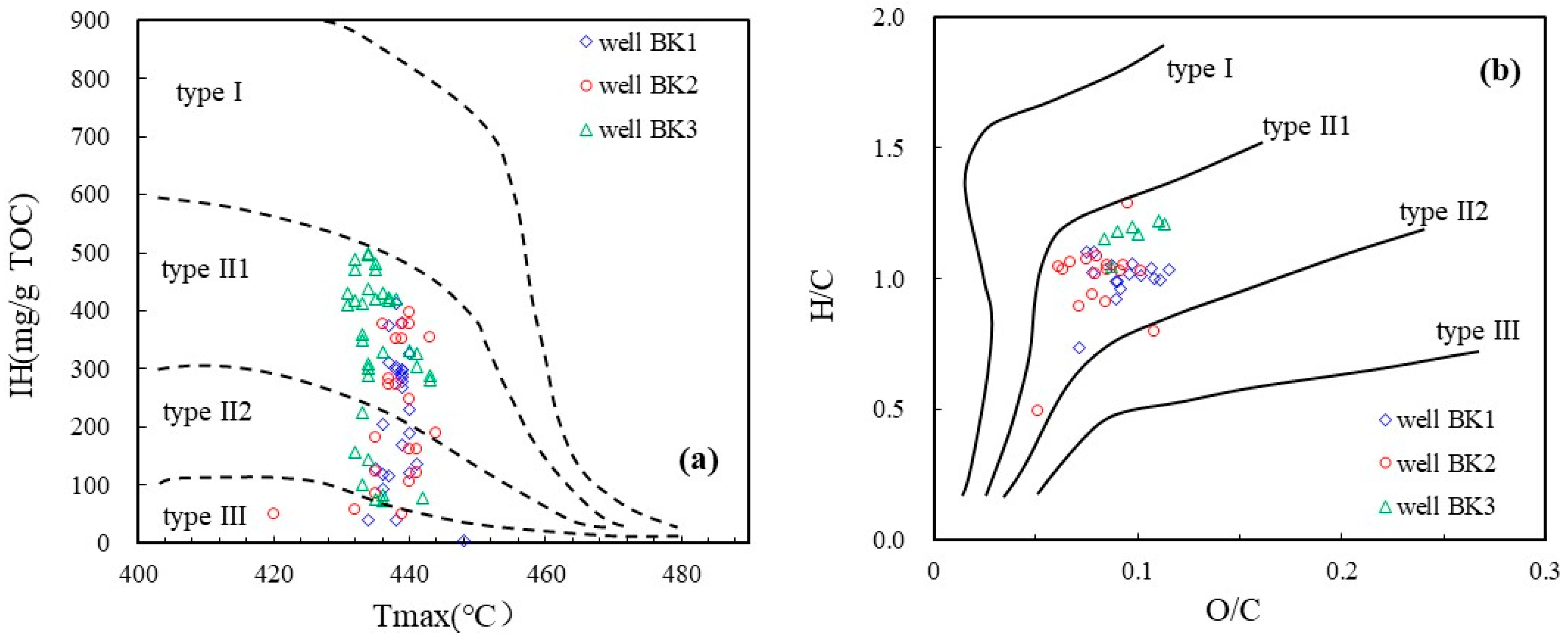



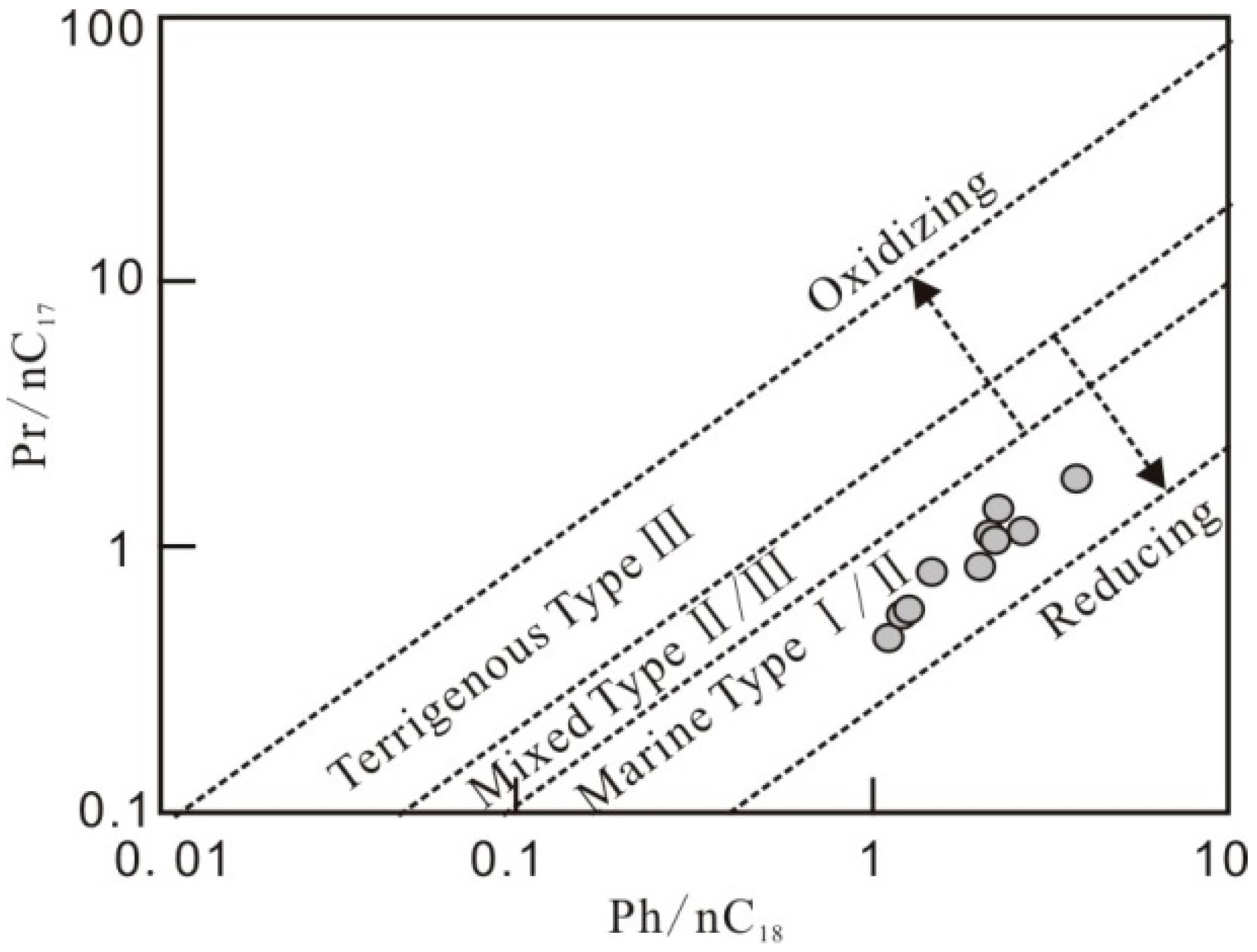
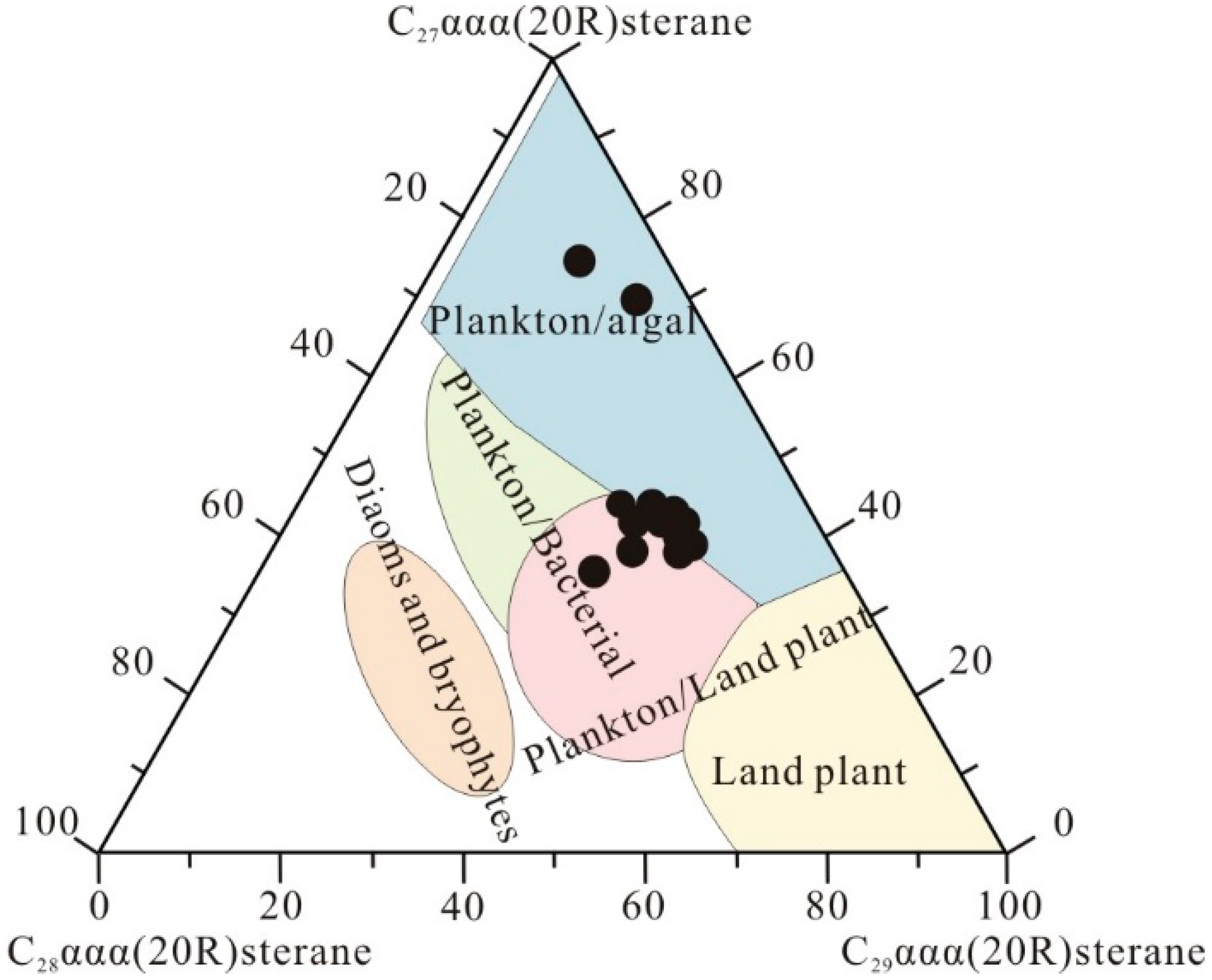

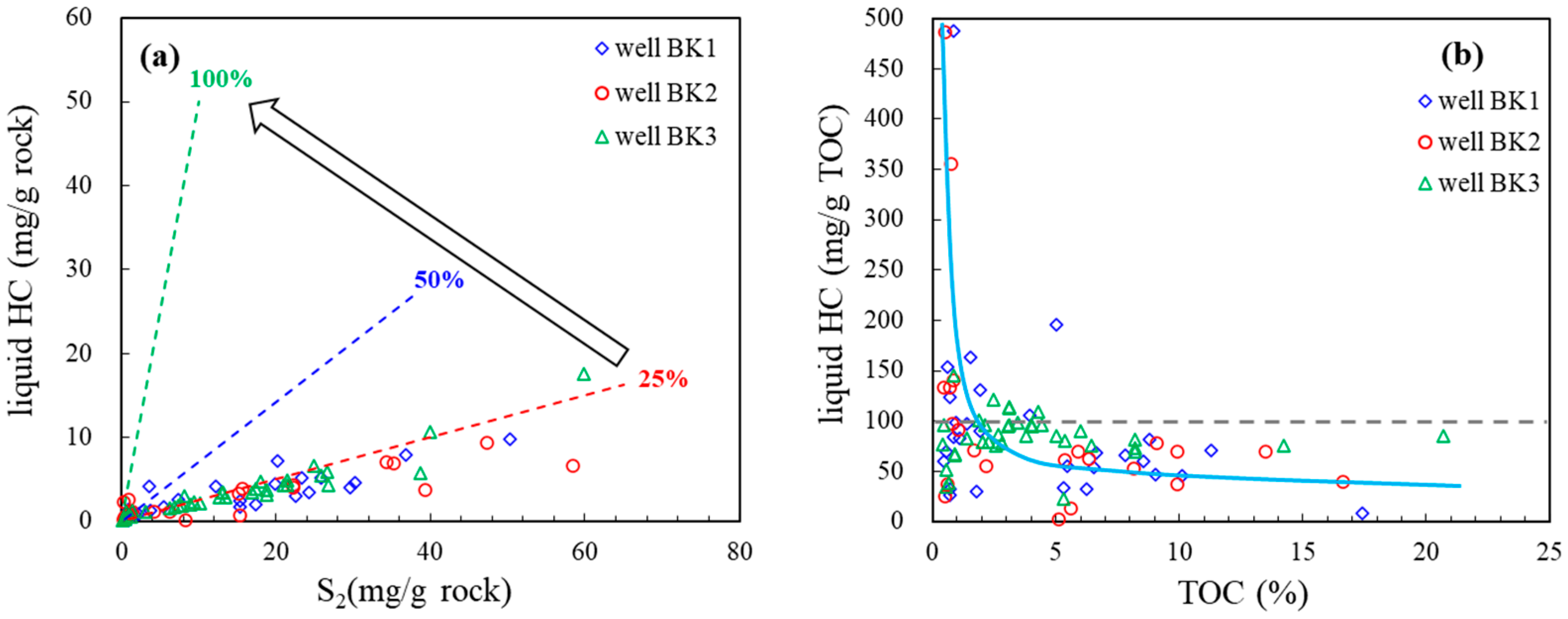
| Well | Depth | Sapropelic | Exinite | Vitrinite | Inertinite | TI | Kerogen Type |
|---|---|---|---|---|---|---|---|
| (m) | (%) | (%) | (%) | (%) | |||
| BK1 | 2.6 | 52.50 | 5.00 | 37.50 | 5.00 | 21.88 | II2 |
| BK1 | 6.94 | 49.53 | 3.74 | 43.30 | 3.43 | 15.50 | II2 |
| BK1 | 7.78 | 65.56 | 5.30 | 22.85 | 6.29 | 44.78 | II1 |
| BK1 | 9.98 | 70.07 | 3.62 | 23.03 | 3.29 | 51.32 | II1 |
| BK1 | 12.17 | 74.36 | 3.21 | 18.91 | 3.53 | 58.25 | II1 |
| BK1 | 13.86 | 69.06 | 3.75 | 22.19 | 5.00 | 49.30 | II1 |
| BK1 | 15.21 | 85.48 | 1.65 | 9.57 | 3.30 | 75.83 | II1 |
| BK1 | 17.87 | 84.49 | 3.30 | 8.58 | 3.63 | 76.07 | II1 |
| BK1 | 21.58 | 83.12 | 2.55 | 10.51 | 3.82 | 72.69 | II1 |
| BK1 | 24.5 | 76.40 | 4.97 | 12.73 | 5.90 | 63.43 | II1 |
| BK1 | 29.3 | 77.22 | 3.48 | 16.14 | 3.16 | 63.69 | II1 |
| BK1 | 38.8 | 55.78 | 4.29 | 33.66 | 6.27 | 26.40 | II2 |
| BK1 | 48.9 | 64.41 | 4.71 | 26.18 | 4.71 | 42.43 | II1 |
| BK1 | 58.6 | 69.06 | 5.63 | 21.56 | 3.75 | 51.95 | II1 |
| BK1 | 60 | 69.75 | 3.82 | 22.93 | 3.50 | 50.96 | II1 |
| BK1 | 71.8 | 71.79 | 3.13 | 20.06 | 5.02 | 53.29 | II1 |
| BK2 | 2.4 | 72.93 | 5.10 | 18.79 | 3.18 | 58.20 | II1 |
| BK2 | 3.77 | 75.74 | 3.61 | 14.43 | 6.23 | 60.49 | II1 |
| BK2 | 5.98 | 75.66 | 2.96 | 16.12 | 5.26 | 59.79 | II1 |
| BK2 | 12.1 | 82.84 | 4.95 | 8.58 | 3.63 | 75.25 | II1 |
| BK2 | 17.6 | 74.37 | 4.11 | 15.51 | 6.01 | 58.78 | II1 |
| BK2 | 23.75 | 71.43 | 3.25 | 19.16 | 6.17 | 52.52 | II1 |
| BK2 | 25.3 | 65.71 | 5.13 | 22.76 | 6.41 | 44.79 | II1 |
| BK2 | 28.6 | 76.80 | 5.33 | 12.85 | 5.02 | 64.81 | II1 |
| BK2 | 31.56 | 79.10 | 2.89 | 12.22 | 5.79 | 65.59 | II1 |
| BK2 | 35.6 | 76.87 | 5.21 | 14.66 | 3.26 | 65.23 | II1 |
| BK2 | 37.5 | 77.04 | 5.35 | 12.26 | 5.35 | 65.17 | II1 |
| BK2 | 39.86 | 76.60 | 6.41 | 12.82 | 4.17 | 66.03 | II1 |
| BK2 | 42.7 | 65.47 | 3.58 | 25.73 | 5.21 | 42.75 | II1 |
| BK2 | 49 | 82.32 | 2.57 | 10.93 | 4.18 | 71.22 | II1 |
| BK2 | 50.25 | 64.72 | 5.18 | 23.95 | 6.15 | 43.20 | II1 |
| BK2 | 53.7 | 73.86 | 3.27 | 16.01 | 6.86 | 56.62 | II1 |
| BK2 | 58.1 | 81.96 | 4.11 | 9.81 | 4.11 | 72.55 | II1 |
| BK3 | 3.7 | 78.10 | 5.23 | 13.07 | 3.59 | 67.32 | II1 |
| BK3 | 7.8 | 81.37 | 6.54 | 8.50 | 3.59 | 74.67 | II1 |
| BK3 | 14.7 | 75.39 | 5.68 | 15.46 | 3.47 | 63.17 | II1 |
| BK3 | 19.3 | 77.33 | 5.90 | 12.11 | 4.66 | 66.54 | II1 |
| BK3 | 23.3 | 80.92 | 3.95 | 11.84 | 3.29 | 70.72 | II1 |
| BK3 | 27.1 | 78.39 | 2.90 | 16.13 | 2.58 | 65.16 | II1 |
| BK3 | 30.5 | 67.54 | 2.62 | 24.59 | 5.25 | 45.16 | II1 |
| BK3 | 34.3 | 71.80 | 6.23 | 16.72 | 5.25 | 57.13 | II1 |
| BK3 | 38 | 72.67 | 5.79 | 17.36 | 4.18 | 58.36 | II1 |
| BK3 | 43.4 | 73.33 | 4.76 | 19.37 | 2.54 | 58.65 | II1 |
| BK3 | 53.5 | 83.60 | 3.15 | 11.36 | 1.89 | 74.76 | II1 |
| BK3 | 58.6 | 85.29 | 1.96 | 9.80 | 2.94 | 75.98 | II1 |
| BK3 | 61.1 | 41.80 | 5.14 | 51.13 | 1.93 | 4.10 | II2 |
| BK3 | 65.8 | 76.03 | 4.73 | 16.09 | 3.15 | 63.17 | II1 |
| BK3 | 68.3 | 83.12 | 1.91 | 12.42 | 2.55 | 72.21 | II1 |
| Depth (m) | 1 | 2 | 3 | 4 | 5 | 6 | 7 | 8 | |
|---|---|---|---|---|---|---|---|---|---|
| Source rock samples from BK3 | 5.6 | 38 | 22 | 39 | 0.45 | 0.63 | 0.38 | 0.16 | 1.03 |
| 7.9 | 42 | 16 | 42 | 0.45 | 0.62 | 0.39 | 0.15 | 0.99 | |
| 10.1 | 43 | 15 | 41 | 0.45 | 0.63 | 0.40 | 0.14 | 0.95 | |
| 15.3 | 42 | 15 | 43 | 0.45 | 0.63 | 0.38 | 0.15 | 1.02 | |
| 19.5 | 39 | 15 | 46 | 0.46 | 0.62 | 0.35 | 0.17 | 1.18 | |
| 25.1 | 40 | 16 | 43 | 0.45 | 0.61 | 0.38 | 0.18 | 1.08 | |
| 27.6 | 38 | 17 | 45 | 0.45 | 0.62 | 0.33 | 0.18 | 1.19 | |
| 33.0 | 40 | 16 | 44 | 0.46 | 0.60 | 0.35 | 0.18 | 1.11 | |
| 35.2 | 40 | 16 | 44 | 0.47 | 0.62 | 0.33 | 0.16 | 1.09 | |
| 53.2 | 44 | 17 | 39 | 0.48 | 0.60 | 0.38 | 0.14 | 0.88 | |
| 57.4 | 70 | 5 | 25 | 0.47 | 0.68 | 0.98 | 0.11 | 0.36 | |
| 60.0 | 42 | 17 | 41 | 0.46 | 0.61 | 0.40 | 0.16 | 0.98 | |
| 65.5 | 36 | 28 | 37 | 0.49 | 0.61 | 0.28 | 0.15 | 1.02 | |
| 69.8 | 42 | 20 | 38 | 0.39 | 0.64 | 0.40 | 0.14 | 0.92 | |
| 73.1 | 75 | 9 | 16 | 0.53 | 0.62 | 0.81 | 0.06 | 0.22 |
Disclaimer/Publisher’s Note: The statements, opinions and data contained in all publications are solely those of the individual author(s) and contributor(s) and not of MDPI and/or the editor(s). MDPI and/or the editor(s) disclaim responsibility for any injury to people or property resulting from any ideas, methods, instructions or products referred to in the content. |
© 2025 by the authors. Licensee MDPI, Basel, Switzerland. This article is an open access article distributed under the terms and conditions of the Creative Commons Attribution (CC BY) license (https://creativecommons.org/licenses/by/4.0/).
Share and Cite
Shi, Y.; Xu, L.; Ma, X.; Guo, J. Study on the Organic Geochemical Characteristics of Jurassic Source Rocks from the Northern Tibetan Plateau Basin. Processes 2025, 13, 3266. https://doi.org/10.3390/pr13103266
Shi Y, Xu L, Ma X, Guo J. Study on the Organic Geochemical Characteristics of Jurassic Source Rocks from the Northern Tibetan Plateau Basin. Processes. 2025; 13(10):3266. https://doi.org/10.3390/pr13103266
Chicago/Turabian StyleShi, Yajun, Li Xu, Xinmin Ma, and Jiajia Guo. 2025. "Study on the Organic Geochemical Characteristics of Jurassic Source Rocks from the Northern Tibetan Plateau Basin" Processes 13, no. 10: 3266. https://doi.org/10.3390/pr13103266
APA StyleShi, Y., Xu, L., Ma, X., & Guo, J. (2025). Study on the Organic Geochemical Characteristics of Jurassic Source Rocks from the Northern Tibetan Plateau Basin. Processes, 13(10), 3266. https://doi.org/10.3390/pr13103266





